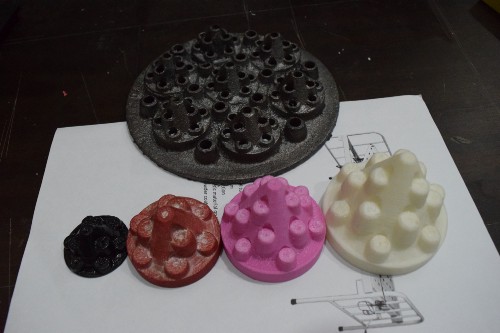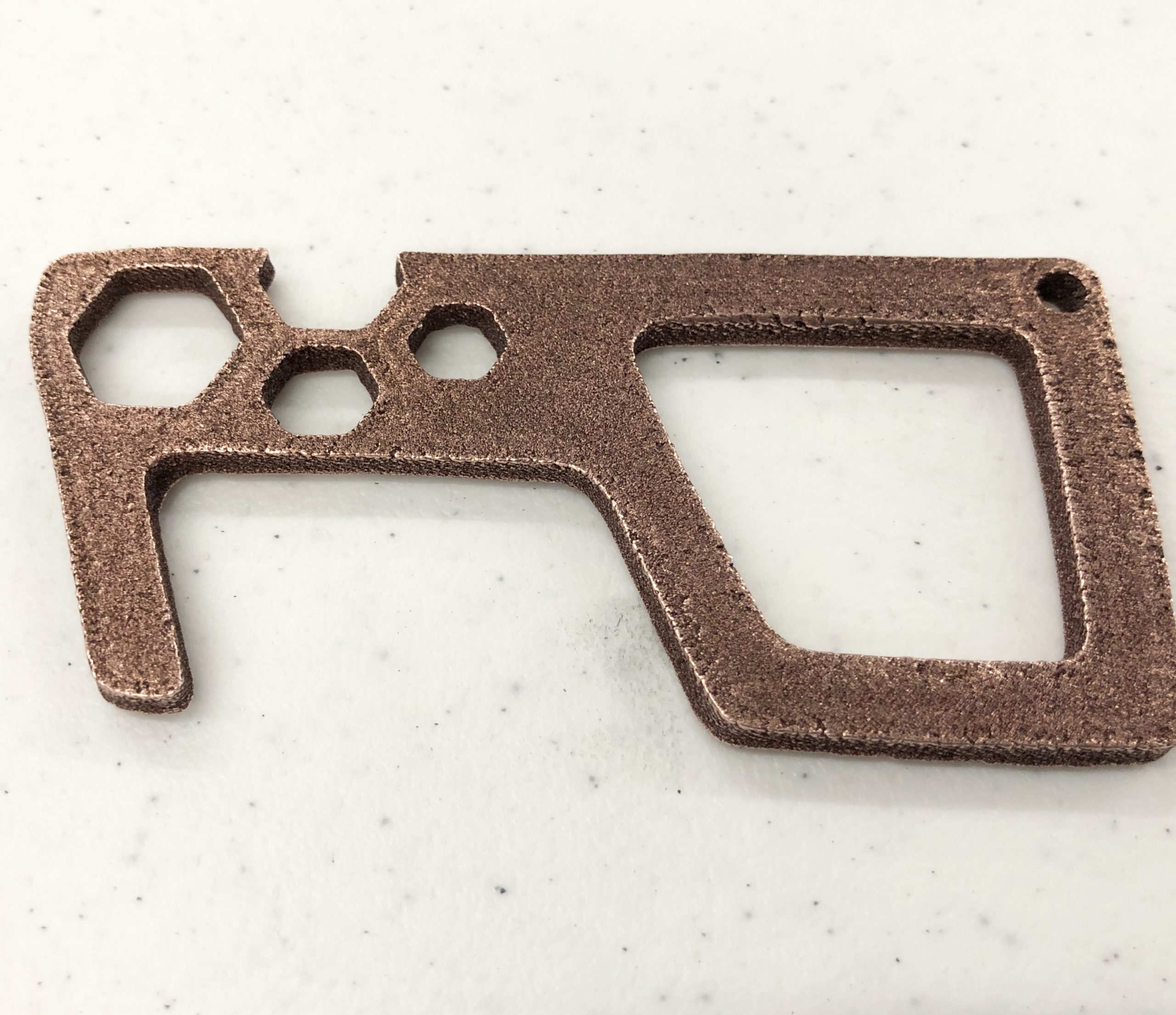Foreshadowing the expansion of bound metal printing by several years, Bradley Woods developed the idea of metal 3D printing filaments in 2014 when he obtained his first 3D printer kit. After 3D printing plastic parts, Woods realized that, in order for desktop 3D printing to truly have an impact, it would need to be able to tackle metal. Because he had already been developing sculpture techniques using powdered metallurgy, he came up with the idea for 3D printing filaments made up of metal powders bound within a polymer matrix.
The Virtual Foundry was born out of a 2015 Kickstarter campaign that raised 107% of its intended goal, allowing Woods to get out of his basement and into a facility stocked with commercial manufacturing equipment. Within two years, the baseline technology matured and the startup was ready for a President to steer the ship, at which point President Tricia Suess joined the company. We spoke to Suess and Woods to learn more about the company.
“Brad started with copper and now we’ve expanded our standard stock to 14 different materials,” Suess said. “We’ve got four ceramics, nine metals, including titanium and aluminum. And then we have one carbon fiber filament, which is our special binder blend with carbon fiber added to it. We also offer custom filaments. We’re making everything in 1.75mm and 2.85mm and in pellet form, too. Brad continuously works on improving the manufacturing process and the usability of the filaments. Over the years, they’ve gotten stronger and easier to work. We’ve also continued to higher and higher loads, which makes sintering it easier and results in a denser product at the end with relatively little shrinkage.”
The company’s materials predate bound metal printing technologies from Markforged and Desktop Metal by two years, with these latter firms introducing their own forms of metal 3D printing in 2017. Both the Metal X from Markforged and the Studio machine from Desktop Metal are closed, dedicated systems, which offer the benefits of something close to a plug-and-play experience but lack the flexibility of using any type of fused filament fabrication 3D printer. Moreover, no chemical solutions are required to debind parts printed with The Virtual Foundry filaments, necessitating only a furnace. All of the above makes The Virtual Foundry more suitable for educational environments.

Parts 3D printed using Steel Filamet from The Virtual Foundry. Fired by Sapphire3D. Image courtesy of Sapphire3D.
It’s worth noting that, with bound metal printing as well as with metal injection molding technologies, there is a trade-off between part density and shrinkage. In the case of copper, the highest density achievable would be about 97 density with 15 percent shrinkage, but shrinkage can be kept to under 7 percent with 10 to 12 percent porosity.
In some cases, this porosity can be an advantage, where parts are designed as filters for instance or where part strength isn’t crucial. Despite this issue with bound metal printing and metal injection molding, useful parts can be fabricated. One example Woods provided was that of a fixture for a machining process, which becomes particularly hot when the object being machined comes in contact with the mill. For that reason, The Virtual Foundry’s carbon fiber material was used for the base, while copper was used for the area that comes into contact with the part. Due to a unique internal geometry, water is able to be circulated through the 3D printed component to keep the part cool.

A collimator for shield radiation 3D printed using The Virtual Foundry’s Tungsten Filamet. Image courtesy of The Virtual Foundry.
The wide array of materials that the company offers opens up some unique applications. For instance, The Virtual Foundry’s tungsten, which weighs a bit less than eight grams per CC, can be used as a nontoxic alternative to lead for radiation shielding and other radiology parts.
When it comes to emergency use, Woods says that the company has seen interest from the U.S. military:
“What they’re doing is dropping these 3D printing pods built inside of shipping containers in a place where they need parts. Currently, they’re doing this with plastic and they’re experimenting with our product to expand in metal parts using the same concept. They’re also doing this on battleships, where they have several problems. They can’t 3D print with powder bed fusion, which is how most metal is 3D printed, because of the movement of the ship. But, using our material, with metal locked in a binder, it doesn’t matter. The same thing is true for operating in little gravity. Powder bed fusion requires gravity. So, we’re doing experiments on that end of the spectrum, also with a group who aims to print structures on the moon using the Filamet process.”
Many of the projects in which The Virtual Foundry’s materials are being used are under wraps. This includes some work exploring the use of copper for COVID-19 supplies, taking advantage of that material’s antimicrobial properties. In addition to antimicrobial parts, it’s not difficult to imagine some emergency situations in which 3D printing copper would be highly advantageous.
A couple of examples immediately popped up for me when I began reviewing the Copper Filamet. One was copper induction coils, an increasingly popular use of copper 3D printing for industry. 3D printing could be used to replace copper coils for metal working tools. A more quotidian use, however, would be to 3D print a copper stovetop coil.

A metal air supply disk with 3D printed prototypes developed by Madhukar KC in Nepal, with 3D printing supplied by Field Ready. The air supply disk is used to provide cleaner, more efficient wood/fuel cooking without a fan or stove for people in Nepal. Image courtesy of Field Ready.
In Nepal, the non-profit Field Ready worked with a local community member to iterate a stovetop design. However, with copper material, it could be possible to 3D print a stovetop itself. As I mentioned in previous articles in this series, I am inexperienced with CAD, however, I was able to find a 2D spiral shape online and then use an online tool to extrude it into 3D. By 3D printing this and sintering it, it would be possible to have an instant stovetop, under which I could heat coals or wood.
And that’s only the start with metal filament. Unfortunately, my SafeKey was too porous for use, but, with a little extra work, some CAD expertise, and a furnace, I could make objects out of titanium, nickel, aluminum and more. According to Suess, the current materials portfolio only represents the tip of the iceberg:
“We want to absolutely expand our bank of materials to include more metals, but also to get into other kinds of materials. We were contacted about possibly making one out of hemp fibers. On the development table now is an ultra light-weight glass bubble filament we are making with 3M.”
As described on the company’s website, “3M glass bubbles are high-strength, low-density hollow glass microspheres made from soda-lime borosilicate glass.” The Virtual Foundry is working with the chemicals giant to develop a method for 3D printing this unique material, an ultra-lightweight filler already used in the aerospace, automotive, energy and construction industries.
“What we’re working on is mostly used in offshore oil drilling,” Woods said. “They use glass bubbles as insulation on the piping that runs under water because it’s low density. So, when you’re done, you can print something, burn off the plastic and you wind up with a piece of glass that you can barely feel it in your hand. It’s incredibly, incredibly lightweight.”
The Virtual Foundry isn’t the only one developing metal filaments for 3D printing. The largest chemical company in the world, BASF, had developed a 3D printable stainless steel material. This makes for stiff competition and one can picture a startup like The Virtual Foundry getting acquired by the German giant. Regardless of exactly what happens, the startup is only beginning its journey. As it expands its materials portfolio and the technology gets into the marketplace, the options for parts that can be 3D printed in emergencies only increases.
Subscribe to Our Email Newsletter
Stay up-to-date on all the latest news from the 3D printing industry and receive information and offers from third party vendors.
You May Also Like
3D Printing Webinar and Event Roundup: April 7, 2024
Webinars and events in the 3D printing industry are picking back up this week! Sea-Air-Space is coming to Maryland, and SAE International is sponsoring a 3D Systems webinar about 3D...
Roboze Brings Performance Polymer 3D Printing to SoCal via New Partnership
High-performance polymer 3D printing firm Roboze has been steadily working to expand its global footprint, with a firm eye on distributed manufacturing, particularly with regard to the oil and gas,...
3D Printing Webinar and Event Roundup: March 3, 2024
In this week’s roundup, we have a lot of events taking place, including SPE’s ANTEC 2024, Futurebuild, the AAOP Annual Meeting, JEC World, and more. Stratasys continues its training courses,...
Advanced Manufacturing Firm Zeda Acquires The Orthopedic Implant Company
Zeda, the San Francisco-based provider of advanced manufacturing solutions, announced that it has acquired The Orthopedic Implant Company (OIC), a medical device manufacturer based in Reno, Nevada, for an undisclosed...
































